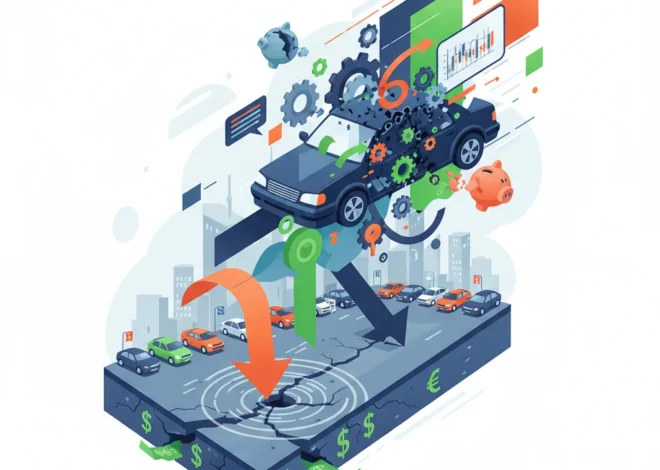
Beyond the Pint: An Investor’s Analysis of the Pub Industry’s Economic Crossroads
The British pub is an institution steeped in history and cultural significance. It’s the quintessential “third place”—a social hub between home and work where communities gather, stories are shared, and pints are poured. Yet, this cornerstone of British life is facing an existential crisis, not from a single threat, but from a confluence of seismic shifts in consumer behavior, technology, and the broader economy. The warning shot was fired recently by Nick Mackenzie, the chief executive of Greene King, one of the UK’s largest pub retailers and brewers. His declaration that cafes and food delivery apps are the new rivals to the traditional pub is more than a headline; it’s a critical signal for investors, business leaders, and anyone with a stake in the consumer discretionary sector.
This isn’t merely a story about changing tastes. It’s a case study in market disruption, a lesson in the evolution of the consumer economy, and a pressing challenge for a multi-billion-pound industry. To understand the future of the pub, we must look beyond the beer taps and analyze the powerful economic and technological forces at play. For those involved in finance and investing, the question is no longer “Which pub has the best ale?” but “Which pub company has the most resilient business model to survive the coming decade?”
The Shifting Tides: Deconstructing the New Consumer Landscape
The foundation of the traditional pub business model—selling large volumes of alcoholic beverages—is cracking. This is primarily driven by a profound generational shift in attitudes towards alcohol. Younger adults, particularly Gen Z and Millennials, are drinking significantly less than their predecessors. According to a 2023 report by the charity Drinkaware, the proportion of 16- to 24-year-olds in the UK who are non-drinkers has risen to 26% (source). This trend towards moderation and wellness is not a fad; it’s a fundamental reshaping of the market.
This demographic is not just shunning alcohol; they are seeking different kinds of social experiences. The “experience economy” dictates that consumers, especially younger ones, prioritize memorable activities over simple transactions. A quiet pint in a corner pub now competes with an artisanal coffee tasting, a competitive board game cafe, or an “Instagrammable” brunch. The pub’s role as the default social venue is being aggressively challenged.
This leads to the core of Mackenzie’s argument: the rise of alternative “third places.” Coffee shops, with their focus on daytime trade, comfortable seating for remote work, and extensive non-alcoholic menus, have captured a significant share of the social market that pubs once dominated. They offer a versatile environment that a traditional “wet-led” pub simply cannot match.
Taiwan's 'T-Dome': The Multi-Billion Dollar Shield Reshaping Global Investment Strategy
The New Competitors: A Strategic Breakdown
To fully grasp the competitive pressure on the pub industry, it’s essential to analyze the value proposition of these new rivals. From an economics perspective, they are not just substitutes; they are fundamentally different models catering to modern demands for convenience, flexibility, and experience.
Let’s compare these business models in a clearer format:
| Attribute | Traditional Pub | Modern Cafe | Food Delivery App (e.g., Deliveroo) |
|---|---|---|---|
| Primary Value Proposition | Alcohol sales, community hub, traditional atmosphere | Premium coffee, daytime socialising, remote work space, light food | Convenience, vast choice, restaurant-quality food at home |
| Key Operating Hours | Primarily evening and weekend | Primarily daytime, 7 days a week | 24/7 availability, peak at meal times |
| Target Audience | Older demographics, local regulars, sports fans | Younger professionals, students, remote workers, families | Time-poor consumers, young adults, families seeking convenience |
| Technology Integration | Historically low; now adopting basic payment tech | High (Wi-Fi, loyalty apps, online ordering) | Core of the business (logistics, payments, marketing) |
| Financial Model | High margin on drinks, lower on food. High fixed costs. | High margin on drinks, moderate on food. Flexible cost structure. | Commission-based, data-driven, reliant on scale and logistics efficiency. A prime example of a fintech platform. |
This table illustrates a stark reality: pubs are being outmaneuvered on multiple fronts. Cafes have captured the daytime economy, while financial technology platforms in the form of delivery apps have cornered the market on at-home convenience. The latter is a particularly insidious competitor. It’s not just a restaurant delivery service; it’s a direct competitor to the entire concept of “going out.” Why venture out for a pub meal when a world of culinary options can be brought to your door with a few taps? This shift has profound implications for footfall, revenue, and ultimately, the valuation of pub assets on the stock market.
Economic Headwinds and the Investment Thesis
Beyond changing consumer habits, the pub sector is weathering a perfect storm of economic pressures. Soaring energy costs, food price inflation, and a tight labor market are squeezing margins to unsustainable levels for many operators. According to the Office for National Statistics, costs for accommodation and food service activities have seen some of the sharpest increases across the UK economy (source). These macroeconomic factors exacerbate the competitive threat, making it harder for pubs to invest in the very changes they need to survive.
For those engaged in investing, this presents a complex picture. On one hand, the sector appears high-risk. The stock prices of listed pub companies often reflect this volatility, making short-term trading a risky proposition. On the other hand, moments of intense pressure can create opportunities. The key is to identify companies with strong balance sheets, savvy management, and a clear strategy for adaptation. An investor’s due diligence should now include questions like:
- How is the company diversifying its revenue streams beyond alcohol?
- What is their strategy for the daytime economy?
- How are they leveraging financial technology to improve operations, from customer-facing apps to back-end banking and inventory management?
- Does the company own its properties (providing a real estate asset base) or is it exposed to rising lease costs?
The integration of fintech is no longer a “nice-to-have.” It’s a core survival tool. Efficient payment processing, digital loyalty programs, and data analytics to understand customer spending patterns are essential for competing with tech-native rivals. There’s even a future-facing argument for technologies like blockchain to provide “farm-to-glass” transparency in the craft beer supply chain, appealing to a consumer base that values authenticity and provenance.
The £12 Billion Question: How Abolishing Stamp Duty Could Revolutionize the UK Housing Market
The Blueprint for Reinvention: From Public House to Multi-Purpose Hub
Survival demands evolution. The pub of the future cannot simply be a place that sells beer. It must become a flexible, multi-purpose community hub that offers value throughout the day. The path forward involves a multi-pronged strategy.
1. Diversification of Offering: This is the most immediate priority. It means a serious investment in high-quality food, premium soft drinks, artisanal coffees, and low/no-alcohol options. It means turning the pub into a legitimate dining destination that can compete with restaurants on food delivery platforms, perhaps by partnering with them strategically rather than viewing them solely as rivals.
2. Activation of Space: A pub is a physical asset that is often underutilized for 16 hours a day. Successful operators are turning their spaces into daytime cafes and co-working spots. They are hosting community events, live music, quiz nights, and parent-and-toddler groups. This “activation” creates new revenue streams and embeds the pub more deeply into the fabric of the local community.
3. Technological Embrace: As mentioned, technology is key. A seamless digital experience—from online table bookings to ordering via an app and frictionless payment—is now the baseline expectation for many consumers. Data gathered through these systems is invaluable for tailoring offers and improving service, driving the kind of efficiency that can make or break a business in this tough economy.
Greene King itself is attempting this pivot, investing millions in its pub gardens and infrastructure to broaden its appeal, as noted in the original BBC article. This is the kind of capital expenditure investors should watch closely, as it signals a commitment to long-term adaptation over short-term profit-taking.
The Great Rewiring: Navigating the Multi-Trillion Dollar Shift to an All-Electric Economy
Conclusion: A Bellwether for the Broader Economy
The plight of the British pub is more than a nostalgic concern; it is a real-time indicator of deep-seated trends in our society and economy. The challenges it faces—from generational shifts in behavior to technological disruption and macroeconomic pressures—are the same challenges confronting countless other legacy industries. The “Great Pub Pivot” is a microcosm of the broader economic transformation from a product-based to a service-and-experience-based model.
For business leaders and investors, the lessons are clear. Complacency is a death sentence. Understanding the underlying needs of your customers is more important than protecting a traditional product. And embracing technology, especially fintech, is not a matter of choice but of survival. The pub is not dead, but the pub as we knew it is. The establishments that thrive in the next decade will be those that successfully transform from simple public houses into dynamic, adaptable, and technologically integrated community hubs.

